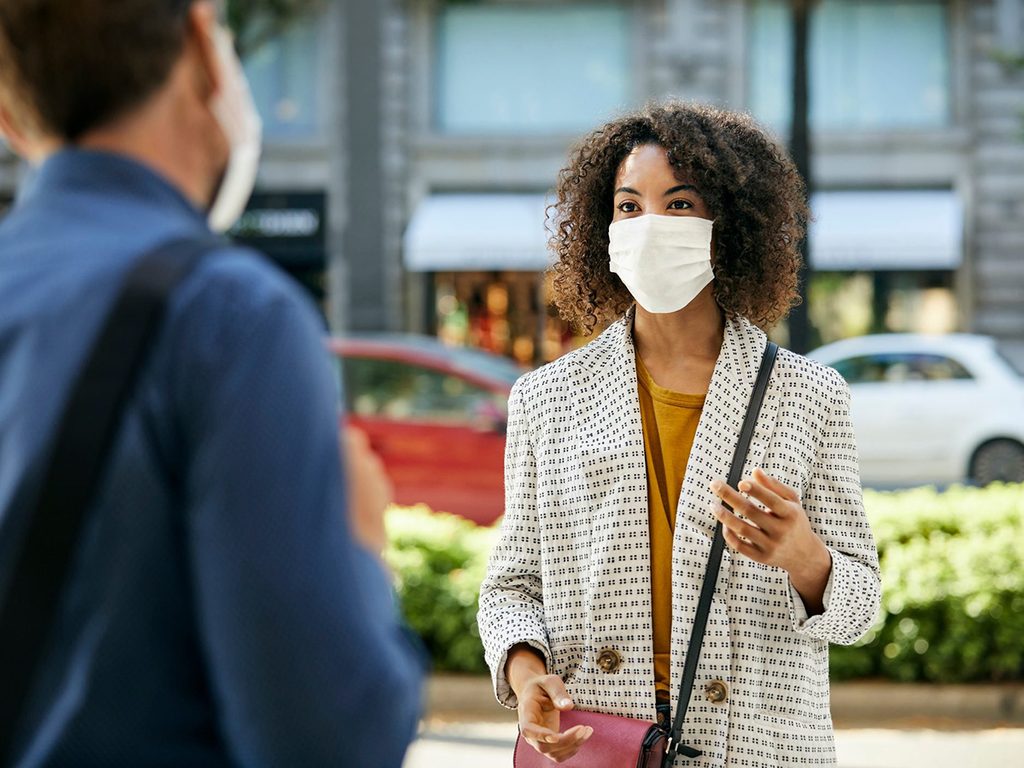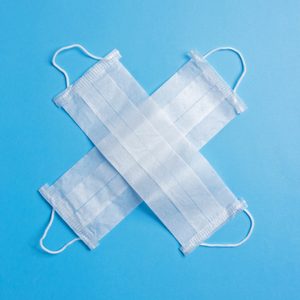How to Read People’s Faces When They Are Wearing a Mask

It's hard to read someone's facial expressions and body language when all you can see is their eyes, but learning to read "eye language" can help. Here's how.
Face masks and learning to read facial expressions
One of the best ways to slow the spread of COVID-19 is to wear a face mask. Several cities in Canada and across the world have mandated the use of face coverings in public places when social distancing can’t be maintained. This often includes grocery stores, pharmacies, schools, workplaces and houses of worship. As the pandemic continues, the use of face masks for day-to-day activities grows, and with it comes a new challenge: how to read faces.
Face masks have long presented challenges for doctors when communicating with patients. That’s because a significant portion of interpersonal communication happens with visual cues, from body language to how you move the muscles of your face, including your lips, nostrils, and cheeks. These areas are all obscured by face masks, making it hard to read a person’s facial expression.
How face masks affect the hearing impaired
For the hearing impaired, reading lips can be crucial to communication. That’s why Samuel Atcherson, a professor from the University of Arkansas at Little Rock department of audiology and speech pathology, worked to develop a face mask with a clear panel to enable lip reading.
In research published in Audiology Today, Atcherson and his colleagues found clear face masks and shields helped people see the mouth and lips, but they made more muffled sounds compared to other masks. For example, a surgical mask can muffle sound by five decibels, while a transparent mask can muffle sound between 12 to 13.3 decibels. (Here’s what doctors need you to know about face masks.)
Meanwhile, a homemade mask made of transparent cloth can muffle sound by 21.1 decibels. Transparent face masks are only a temporary fix to a bigger problem, especially for the hearing impaired.
But it’s not just those with hearing impairments who are finding it challenging to communicate in the age of mask-wearing. People tend to heavily rely on lip reading when communicating in person (even if that process is largely unconscious).
What society is left with, however—i.e., communicating via the eyes—is quite workable, according to Patti Wood, a body language and nonverbal communication expert and author of seven books on communication including, SNAP: Making the Most of First Impressions, Body Language, and Charisma.
The eyes don’t lie
“Our eyes have evolved to respond involuntarily to what we see and perceive,” says Wood. For example, when you see something that frightens or threatens you, your eyes naturally widen in order to expand your field of vision and increase the amount of light you’re able to absorb in the moment. Conversely, your eyes narrow to a squint when you focus on something that displeases you. (These are the eight secrets your body language reveals about you.)
A true smile can be seen in the corners of the eyes, with subtle lines that appear as a result of your cheeks drawing upward. Sadness causes your eyes to droop, your eyebrows to knit together, and your eyes to appear inexplicably “blank.”
All of these involuntary responses to your own emotions are difficult, if not impossible, to fake, which is why Wood regards the eyes as windows to your emotional state. It’s also why Wood believes communicating via “eye language” is already second nature for humans.
Any struggle you may feel when attempting to read eyes now may be less about your innate ability to communicate this way and more about your awareness of the absence of the mouth and nose as clues.
That means that over time, as you become more accustomed to communicating with people wearing face masks, you will likely find yourself relying more, and more comfortably, on “eye language.”
In the meantime, here’s how to navigate “eye language” to improve your reading of facial expressions.
Eye contact
Maintaining eye contact is more important than ever, says Wood. “You want to give and get good eye extended eye contact,” she says, because research shows sustained eye contact increases feelings of understanding and empathy, both the feelings you feel towards others, and the feelings they’re inspired to feel toward you. (Here’s how to stop your glasses from fogging up while wearing a mask.)
What may not come as second nature, Wood notes, is that people with higher self-esteem tend to be better at maintaining extended eye contact.
That said, it’s possible to work on giving good eye contact, Wood says. By practicing holding eye contact when you’re speaking with someone, you unconsciously increase your connection and ability to feel empathy for them.
Those lying eyes
Have you ever tried to have a meaningful conversation with someone who keeps closing their eyes as they talk? It can be disconcerting. As Wood explains, eye-closing is a “tell” that the other person is lying. Physiologically, as you lie, you’re also struggling to continue to look into the other person’s eyes. Sometimes the eyes gaze downward, which could mean some other things (discussed later). More often, however, your eyes close or blink very slowly. (This is how to spot the six sure-fire signs that someone is lying.)
That downward gaze
Gazing downward can mean several different things, according to Wood. It can mean someone is lying. But it can also indicate someone is experiencing a deep emotion, particularly if the person is gazing downward in the direction of their dominant side.
Since deciphering this requires knowing whether the person is right- or left-handed, it’s best not to rely on the downward gaze, alone, as a sign of deep emotion. This is especially true when the downward gaze can also indicate deception, as well as submission, intimidation and shame.
So, that downward gaze is definitely telling you something. What it is can be revealed in other clues, including the person’s actual words and other clues. (Here are nine body language tricks to instantly get what you want.)
Happy versus sad
As noted above, happy eyes have a distinctive appearance. They crinkle at the outside corners as a result of your cheeks pushing them upward. Sad eyes droop, and the eyes themselves seek less interpersonal engagement, giving them a dull or “blank” appearance.
Surprise
You don’t need to see another person’s mouth wide open to know they’re surprised, says Wood. “You really don’t need anything except the eyes, which widen, and the brows, which raise up.”
Anger
You won’t see someone’s nostrils flaring or lips flattening into a hard line when they’re wearing a mask properly, but you will see their eye muscles tense up and their eyebrows draw downward. Moreover, their eyes themselves may stare hard at the source of anger, the pupils motionless the glare unmistakable. (Avoid these questions that polite people never ask.)
Disgust
As noted above, when someone’s eyes narrow to a squint as they focus intently on something, it’s a reliable sign of disgust. In addition, the eyebrows lower and the brow, as a whole, appears tense. Also, someone who is disgusted may wrinkle their nose, which a mask wouldn’t hide. You too may find yourself squinting, to some extent, as your brain struggles to protect you by limiting your ability to see this person.
Anxiety
Anxiety typically causes the eyes to blink frequently. You may feel your own eyes fluttering if you’re talking to someone in a mask whose eyes are blinking. (Don’t miss these seven signs of high-functioning anxiety.)
Attraction
If you’re meeting someone for the first time while wearing a mask, there’s a lot that their eyes can tell you. One is what their intentions are. While a man may flash his eyebrows when he’s attracted to someone, it also suggests kind intentions. The raised brow, according to Wood, is like saying, “I come in friendship. I want you to feel comfortable with me.”
Conversely, if his eyes are squinted into a narrow focus, it could be he is unconsciously communicating aggression. And in this context, that could mean he is interested in nothing more than a physical connection.
Sources:
- Centers for Disease Control and Prevention: “Absence of Apparent Transmission of COVID-19 With Masks”
- Centers for Disease Control and Prevention: “Absence of Apparent Transmission of SARS-CoV-2 from Two Stylists After Exposure at a Hair Salon with a Universal Face Covering Policy — Springfield, Missouri, May 2020”
- All About the Human Ear: “Lip-reading for non-hearing impaired individuals”
Next, this is what you need to know about COVID-19 in Canada, according to a germ expert.






